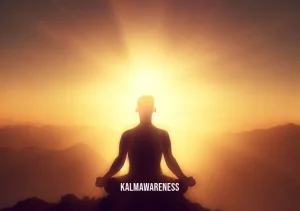The Dance of the Thinking Mind and Observing Mind: A Journey to Inner Awareness
As we traverse the pathways of human cognition and consciousness, we stumble upon a fascinating interplay between the thinking mind and the observing mind. This intricate relationship is vital to our understanding of self-awareness, presence, and the deeper realms of consciousness. While many perceive thoughts as mere cognitive processes, they are in fact a reflection of our deeper selves, shaped by a lifetime of experiences and learning.
The Thinking Mind
The thinking mind is a ceaseless generator of thoughts, ideas, and interpretations. It’s the part of us that plans, worries, dreams, and analyzes. It often holds onto past regrets or looks forward anxiously to the future, asking questions like “Who am I, Lord, that you are mindful of me?“. This mind often becomes a blamer, attributing external circumstances to internal feelings.
However, it’s essential to understand that a thought is just a thought. Thoughts arise and dissolve, fleeting and transient. Recognizing this fact is the first step to gaining mastery over our thinking mind, and not being ensnared by its repetitive patterns.
The Observing Mind
On the other end of the spectrum lies the observing mind. This facet of our consciousness is the silent witness, the observer of our thoughts and feelings. It doesn’t judge, analyze, or critique; it merely observes with a detached awareness. It’s the part of us that, during moments of introspection, can point at self in mirror and observe without being swayed by emotions.
The observing mind is deeply connected to the present moment. It understands the profound wisdom in the statement, “And remember, no matter where you go, there you are“. The magic of the observing mind is its ability to be fully present, realizing the importance of being present in the moment.
Bridging the Two Through Meditation
One might wonder, how does one foster a relationship between the thinking and observing minds? The answer lies in the ancient practices of meditation and mindfulness. Through techniques such as breathing meditation or even specialized practices like elephant meditation, individuals can train themselves to shift from an active thinking state to a more relaxed observing state.
A documentary on meditation aptly depicts the transformative power of these practices. When we meditate, we give ourselves the space to relax and be aware. Even if it’s a short 7-minute meditation, the journey inward helps bridge the gap between the incessant chatter of the thinking mind and the serene observation of the observing mind.
The Body’s Role in Awareness
Our bodily experiences also play a pivotal role in understanding our thinking and observing minds. Through practices like touching a body part mindfully or diving deep into embodiment and the inner life, we can anchor ourselves in the present moment. Our physical being becomes a gateway to heightened self-reflection and presence.
Journey Ahead
As we move forward, it’s essential to recognize that the journey between the thinking and observing minds is not linear. There will be moments of clarity, and there will be times when things fall apart. However, the tools we’ve discussed provide a framework for navigating this inner landscape with grace and awareness.
Join us as we delve deeper into the intricacies of these two aspects of the mind, exploring techniques, stories, and insights that can enrich our understanding and experience. Dive into the world of presence, self-reflection, and true awareness, as we explore further in the next segment. Your journey to inner enlightenment is just beginning. Continue reading.

Navigating the Nuances of Thinking and Observing Minds
Delving deeper into the realms of the thinking and observing minds, we encounter myriad layers of our cognitive processes and conscious awareness. While the previous chapter laid the foundational understanding, let’s now peel back the layers to unveil the intricate dynamics that govern these two pillars of our consciousness.
Subtleties of the Thinking Mind
The thinking mind, often termed the conscious intellect or analytical brain, doesn’t merely ponder over day-to-day tasks. It delves into:
- Memory Recollection: Accessing past events and experiences, which form our personal narratives and influence our daily decisions.
- Forward Projection: Dreaming, planning, and worrying about the future, often influencing our current choices.
- Rational Analysis: Weighing pros and cons, making decisions, and problem-solving.
- Emotional Responses: The mind’s reaction to external stimuli, which is often filtered through past experiences and beliefs.
It’s this aspect of the mind that often finds itself coming around to ruminate on the same thoughts, beliefs, and patterns.
The Quietude of the Observing Mind
Unlike the constantly active thinking mind, the observing mind, sometimes referred to as the watcher or passive awareness, operates on a different frequency. It’s characterized by:
- Non-judgment: It observes without assigning labels or emotions.
- Present Moment Awareness: The observing mind exists in the now, appreciating the real-eyes meditation.
- Detachment: Distanced from emotional entanglement, it offers a bird’s-eye view.
- Silent Understanding: Instead of vocal analytical reasoning, the observing mind silently understands the essence.
One could say this facet of the mind embraces the idea that every moment, every experience, is like an inspiring video, best watched without commentary.
Distinctive Features: Thinking Mind vs. Observing Mind
| Features | Thinking Mind | Observing Mind |
|---|---|---|
| Primary Function | Analysis & Decision Making | Silent Observation |
| Temporal Focus | Past & Future | Present Moment |
| Mode of Operation | Active & Engaging | Passive & Detached |
| Associated Feeling States | Stress, Anxiety, Excitement, Worry | Peace, Equanimity, Stillness |
| Approach to Situations | Problem-solving | Acceptance & Non-reactivity |
This table provides a snapshot, helping to discern the operational differences and similarities between the two facets of our mind.
Cultivating a Balance
The art lies not in silencing the thinking mind or amplifying the observing mind, but in striking a harmonious balance between the two. This balance aids in:
- Enhanced Self-awareness: Tuning into one’s true nature and understanding self at a deeper level.
- Effective Decision-making: Using the analytical prowess of the thinking mind and the detached clarity of the observing mind.
- Stress Reduction: While the thinking mind might spiral into anxiety, the observing mind can provide grounding.
The journey, therefore, is not about favoring one over the other but learning to dance gracefully between the two, much like an elephant’s meditative stride.
Preparing for the Next Chapter
As we peel back more layers in our exploration of the thinking and observing minds, the subsequent chapter promises to immerse you in techniques and practices to harness their collective power. Whether it’s finding alignment, embracing presence, or cultivating mindfulness, there’s a wealth of knowledge awaiting.
Dive deeper with us into this captivating world of self-awareness and cognitive exploration in the next segment. Your journey to understanding and balancing your mind’s facets is only beginning. Continue reading.

Embracing the Hope within the Thinking and Observing Minds
Hope is an ever-glowing ember in the human spirit, a driving force that propels us forward even in the face of adversity. When we apply this concept of hope to the interplay between the thinking mind and the observing mind, we open ourselves to a myriad of possibilities and inspirations.
The Power of Perspective
One of the most inspiring aspects of the thinking and observing minds is their innate ability to shift perspectives. By simply toggling between analysis and observation, we can find hope in seemingly dire situations.
Jane, for instance, faced a debilitating illness. Her thinking mind constantly reminded her of the pain and limitations. But with mindfulness practices inspired by teachings from the embodiment and the inner life, she engaged her observing mind. It allowed her to detach from her pain momentarily and appreciate the strength and resilience she was developing.
“Hope is being able to see that there is light despite all of the darkness.” – Desmond Tutu
The Promise of Growth
Engaging the thinking and observing minds doesn’t just offer solace during challenges; it promises growth. The duality allows us to introspect, analyze our actions, and accept them without judgment.
Consider Raj, who struggled with feelings of inadequacy in his professional life. By channeling his observing mind, inspired by practices like real-eyes meditation, he could see these feelings objectively. He then used his thinking mind to strategize career development steps, leading him to newfound success and satisfaction.
“The only time you fail is when you fall down and stay down.” – Stephen Richards
Turning Adversity into Opportunity
When we harness the thinking mind’s problem-solving prowess with the observing mind’s equanimity, adversity transforms into opportunity.
Sarah, after losing her job unexpectedly, found herself in a spiral of despair. However, using tools like relax and be aware techniques, she shifted her focus. Her thinking mind identified freelance opportunities, and her observing mind helped her embrace this new phase with hope and openness.
“It’s not about waiting for the storm to pass but learning to dance in the rain.” – Vivian Greene
Lessons from the Past
History is replete with stories of individuals who, armed with the power of their thinking and observing minds, overcame insurmountable odds.
Mahatma Gandhi, through deep introspection and observation, tapped into non-violence as a potent tool against oppressive regimes. His thinking mind strategized the path of civil disobedience, while his observing mind maintained a steadfast focus on the broader goal.
“Strength does not come from physical capacity. It comes from an indomitable will.” – Mahatma Gandhi
Navigating Forward with Hope
The thinking and observing minds, though seemingly opposing forces, harmoniously blend to become our beacon of hope. They allow us to see beyond the present, visualize a brighter future, and take concrete steps towards realizing it. As we’ve learned from personal stories and historical figures, these two facets of the mind, when harmonized, can lead to transformative outcomes.
Anticipate a journey ahead that explores the myriad techniques to further harness the thinking and observing minds, delving into practices that not only bring mental clarity but also spiritual elevation. Your exploration into the depths of cognitive wonder is set to reach even more profound revelations. Continue reading in the next chapter, as we further unlock the potential of these powerful facets of consciousness.
@
Unraveling the Layers: An In-depth Analysis of Thinking and Observing Minds
As we’ve journeyed through the realms of thinking and observing minds, we’ve touched upon their interplay, their manifestations, and their transformative power. In this chapter, we will deconstruct and delve deeper, using structured formats to simplify and elucidate the complexities inherent in these two aspects of cognition and consciousness.
Core Functions of the Thinking Mind
The thinking mind, often referred to as the analytical or rational mind, boasts a myriad of functions:
- Problem Solving: Using logic and reasoning to find solutions.
- Memory Access: Recalling past events, experiences, and learned information.
- Planning: Charting out future actions, setting goals, and devising strategies.
- Emotional Processing: Interpreting and sometimes getting entangled with emotions and feelings, reminding us of moments when we come around to similar situations or feelings.
Pivotal Roles of the Observing Mind
The observing mind, sometimes called the passive or detached mind, has its unique set of attributes:
- Neutral Observation: Watching thoughts, emotions, and events without judgment.
- Presence: Being fully in the moment, drawing insights from teachings such as being present.
- Detachment: Providing a space between stimulus and response, ensuring non-reactivity.
- Wholeness: Recognizing the interconnectedness of experiences, fostering acceptance and understanding.
Breaking Down the Interplay
Understanding how these two facets of the mind interact is pivotal. Here’s a step-by-step breakdown:
- Stimulus Reception: Both minds receive an external or internal stimulus.
- Example: Hearing a disparaging comment.
- Thinking Mind Reacts: It immediately starts analyzing, judging, and often reacting.
- Example: Feeling hurt, recalling past similar incidents, feeling anger or sadness.
- Observing Mind Watches: It notices the reactions without getting involved.
- Example: Recognizing the feeling of hurt without attaching a story to it.
- Decision Making: With awareness from both minds, an informed, balanced response or action is chosen.
- Example: Addressing the comment calmly or choosing to let it go, using insights from practices like relax and be aware.
- Feedback Loop: The thinking mind learns from the observing mind’s neutrality, helping in personal growth and evolution.
Real-Life Application
When applied to everyday scenarios, the synchronicity between the thinking and observing minds can be transformational. Here are some scenarios:
- Conflict Resolution: Using the thinking mind to understand the issue and the observing mind to stay calm, ensuring a balanced approach.
- Goal Setting: The thinking mind plots the path, while the observing mind ensures we stay grounded and present during the journey.
- Emotional Well-being: Drawing insights from resources like real-eyes meditation, one can navigate emotional landscapes with clarity and peace.
Preparing for the Climax
With a clearer understanding of the thinking and observing minds’ intricacies and their profound impact on our daily lives, we stand at the brink of culmination. The upcoming chapter promises to be not just a conclusion but a beginning to a lifetime of enriched self-awareness and cognitive mastery.
Embark on the final leg of this enlightening journey, where we will weave together the myriad threads of insights, practices, and transformative potentials of the thinking and observing minds. Continue reading to experience this culmination and to step forward with newfound wisdom.
@
Reflecting on the Dance of the Thinking and Observing Minds
Our exploration into the realms of the thinking and observing minds has been both enlightening and transformative. These twin facets of our consciousness, with their unique roles and interplays, offer a profound understanding of self-awareness, presence, and cognitive mastery.
Journey Revisited
Let’s reminisce about the waypoints we traversed:
- Introduction to Duality: Unveiling the ceaseless generator of thoughts, the thinking mind, and its tranquil counterpart, the observing mind.
- The Deep Dive: The power of perspective, promise of growth, and turning adversity into opportunity, highlighted by inspirational quotes and real-life narratives.
- The Breakdown: An analytical look into the functions and interplay of both minds, offering structured insights and practical applications.
Real-world Implications
Understanding the dynamics of the thinking and observing minds isn’t just theoretical wisdom; it’s a life skill. By recognizing when to engage our analytical brain and when to step back and observe, we can:
- Manage Stress: By distancing ourselves from immediate reactions and emotions, using tools like relax and be aware techniques.
- Make Informed Decisions: Combining the analytical prowess of the thinking mind with the detached clarity of the observing mind.
- Foster Personal Growth: Harnessing the feedback loop between the two minds to evolve and transform continually.
A Heartfelt Note of Gratitude
Thank you, dear readers, for embarking on this enlightening journey with us. Your commitment to understanding these cognitive realms showcases an innate curiosity and a desire for personal growth. We’re humbled to have been a part of your exploration and hope the insights shared serve you well in your daily endeavors.
More Awaits You
This exploration on the thinking and observing minds is just the tip of the iceberg. Our platform offers a plethora of resources, articles, and insights on similar topics. Curious about other mindfulness practices? Dive into our section on meditative techniques. Interested in further self-exploration? Our articles on embodiment and inner life might resonate.
Call-to-Action: We encourage you to revisit previous sections for clarity, share these insights with loved ones, or even pen down your reflections. And as always, keep exploring, keep growing, and remember – every journey within brings about a change without.
Looking forward to guiding you through more journeys of insight and self-discovery in our future editions. Until then, stay curious and stay inspired!




